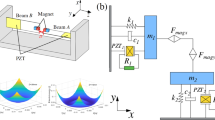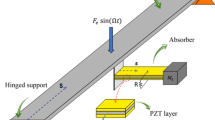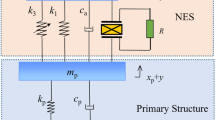Abstract
This paper investigates the dynamical responses and performances of mono-, bi-, and tri-stable nonlinear energy sinks in simultaneous vibration suppression and energy harvesting as well as solely vibration mitigation. To this end, a realizable multi-stable nonlinear energy sink composed of a bimorph cantilever beam and arrays of magnets is considered for vibration mitigation. The target vibrating structure is a simply-supported beam under a harmonic excitation. The proposed absorber can exhibit multi-stability based on the magnet gaps. First, using extended Hamilton’s principle, the coupled continuous magneto-electromechanical equations governing the system are obtained. Next, the bifurcations of the absorber fixed points that lead to different stability states are analyzed. Then, the time- and frequency-responses of the coupled system are studied using time integration. The results show that the bi- and tri-stable absorbers perform well in case of strongly modulated responses. Furthermore, the response of the coupled system is verified using the harmonic balance method and pseudo-arclength continuation. Next, the potential well escape method based on the harmonic balance solution is exploited to investigate the strongly modulated response emergence and disappearance as well as its variations with the system parameters. The coupling mechanism of the nonlinear absorber to the host beam is also studied using linearization and compared with the harmonic balance solution. In addition, in order to compare the performances of the bi-stable and tri-stable absorbers, energy-based analyses are performed. The results reveal the average harvested power per average kinetic energy of the main system for a bi-stable absorber is higher than a tri-stable absorber. Furthermore, the bi-stable absorber can mitigate the host structure vibration more than the tri-stable absorber. Finally, it is observed that the bi-stable absorber suppresses the vibration more than its corresponding mono-stable absorber and harvests more energy over a broader frequency region.






























Similar content being viewed by others
Data Availability
Data sharing is not applicable to this manuscript as no datasets were generated or analyzed during the current study.
References
Daqaq, M.F.: On intentional introduction of stiffness nonlinearities for energy harvesting under white Gaussian excitations. Nonlinear Dyn. 69, 1063–1079 (2012)
Leadenham, S., Erturk, A.: Mechanically and electrically nonlinear non-ideal piezoelectric energy harvesting framework with experimental validations. Nonlinear Dyn. 99(1), 625–641 (2020)
Rezaei, M., Talebitooti, R., Friswell, M.I.: Efficient acoustic energy harvesting by deploying magnetic restoring force. Smart Mater. Struct. 28(10), 105037 (2019)
Xing, J., et al.: Investigating the effect of surface protrusions on galloping energy harvesting. Appl. Phys. Lett. 122(15), 153902 (2023)
Xing, J., et al.: Investigating the coupled effect of different aspect ratios and leeward protrusion lengths on vortex-induced vibration (VIV)-galloping energy harvesting: modelling and experimental validation. J. Sound Vib. 568, 118054 (2024)
Rezaei, M., Talebitooti, R., Rahmanian, S.: Efficient energy harvesting from nonlinear vibrations of PZT beam under simultaneous resonances. Energy 182, 369–380 (2019)
Elvin, N.G., Elvin, A.A.: An experimentally validated electromagnetic energy harvester. J. Sound Vib. 330(10), 2314–2324 (2011)
Khan, F.U., Qadir, M.U.: State-of-the-art in vibration-based electrostatic energy harvesting. J. Micromech. Microeng. 26(10), 103001 (2016)
Chen, J., Wang, Z.L.: Reviving vibration energy harvesting and self-powered sensing by a triboelectric nanogenerator. Joule 1(3), 480–521 (2017)
Ali, S.F., Adhikari, S.: Energy harvesting dynamic vibration absorbers. J. Appl. Mech. 80(4), 041004 (2013)
Harne, R.L.: Development and testing of a dynamic absorber with corrugated piezoelectric spring for vibration control and energy harvesting applications. Mech. Syst. Signal Process. 36(2), 604–617 (2013)
Abdelmoula, H., et al.: Control of base-excited dynamical systems through piezoelectric energy harvesting absorber. Smart Mater. Struct. 26(9), 095013 (2017)
Zoka, H., Afsharfard, A.: Double stiffness vibration suppressor and energy harvester: an experimental study. Mech. Syst. Signal Process. 121, 1–13 (2019)
Rezaei, M., et al.: Integrating PZT layer with tuned mass damper for simultaneous vibration suppression and energy harvesting considering exciter dynamics: an analytical and experimental study. J. Sound Vib. 546, 117413 (2023)
Bab, S., et al.: Vibration mitigation of a rotating beam under external periodic force using a nonlinear energy sink (NES). J. Vib. Control 23(6), 1001–1025 (2017)
Mamaghani, A.E., Khadem, S., Bab, S.: Vibration control of a pipe conveying fluid under external periodic excitation using a nonlinear energy sink. Nonlinear Dyn. 86(3), 1761–1795 (2016)
Saeed, A.S., Abdul Nasar, R., Alhudeifat, M.A.: A review on nonlinear energy sinks: designs, analysis and applications of impact and rotary types. Nonlinear Dyn. 111(1), 1–37 (2023)
Kecik, K.: Assessment of energy harvesting and vibration mitigation of a pendulum dynamic absorber. Mech. Syst. Signal Process. 106, 198–209 (2018)
Kecik, K.: Simultaneous vibration mitigation and energy harvesting from a pendulum-type absorber. Commun. Nonlinear Sci. Numer. Simul. 92, 105479 (2021)
Raj, P.V.R., Santhosh, B.: Parametric study and optimization of linear and nonlinear vibration absorbers combined with piezoelectric energy harvester. Int. J. Mech. Sci. 152, 268–279 (2019)
Kecik, K., Mitura, A.: Energy recovery from a pendulum tuned mass damper with two independent harvesting sources. Int. J. Mech. Sci. 174, 105568 (2020)
Lu, Z.-Q., et al.: Vibration isolation and energy harvesting integrated in a Stewart platform with high static and low dynamic stiffness. Appl. Math. Model. 89, 249–267 (2021)
Nili Ahmadabadi, Z., Khadem, S.E.: Nonlinear vibration control and energy harvesting of a beam using a nonlinear energy sink and a piezoelectric device. J. Sound Vib. 333(19), 4444–4457 (2014)
Kremer, D., Liu, K.: A nonlinear energy sink with an energy harvester: transient responses. J. Sound Vib. 333(20), 4859–4880 (2014)
Kremer, D., Liu, K.: A nonlinear energy sink with an energy harvester: harmonically forced responses. J. Sound Vib. 410, 287–302 (2017)
Xiong, L., et al. On the use of piezoelectric nonlinear energy sink for vibration isolation and energy harvesting. In: ASME 2018 Conference on Smart Materials, Adaptive Structures and Intelligent Systems (2018)
Yao, H., et al.: A tri-stable nonlinear energy sink with piecewise stiffness. J. Sound Vib. 463, 114971 (2019)
Xia, Y., Ruzzene, M., Erturk, A.: Dramatic bandwidth enhancement in nonlinear metastructures via bistable attachments. Appl. Phys. Lett. 114(9), 093501 (2019)
Yao, H., et al.: Multi-stable nonlinear energy sink for rotor system. Int. J. Non-Linear Mech. 118, 103273 (2020)
Yao, H., et al.: Bi-stable buckled beam nonlinear energy sink applied to rotor system. Mech. Syst. Signal Process. 138, 106546 (2020)
Zeng, Y.-C., Ding, H.: A tristable nonlinear energy sink. Int. J. Mech. Sci. 238, 107839 (2023)
Pennisi, G., et al.: Design and experimental study of a nonlinear energy sink coupled to an electromagnetic energy harvester. J. Sound Vib. 437, 340–357 (2018)
Zhou, J., et al.: Suppression of panel flutter response in supersonic airflow using a nonlinear vibration absorber. Int. J. Non-Linear Mech. 133, 103714 (2021)
Chen, L., et al.: Variable-potential bistable nonlinear energy sink for enhanced vibration suppression and energy harvesting. Int. J. Mech. Sci. 242, 107997 (2023)
Rezaei, M., Talebitooti, R., Liao, W.-H.: Exploiting bi-stable magneto-piezoelastic absorber for simultaneous energy harvesting and vibration mitigation. Int. J. Mech. Sci. 207, 106618 (2021)
Rezaei, M., Talebitooti, R., Liao, W.-H.: Investigations on magnetic bistable PZT-based absorber for concurrent energy harvesting and vibration mitigation: numerical and analytical approaches. Energy 239, 122376 (2022)
Fang, S., et al.: Tuned bistable nonlinear energy sink for simultaneously improved vibration suppression and energy harvesting. Int. J. Mech. Sci. 212, 106838 (2021)
Rezaei, M., Talebitooti, R.: Investigating the performance of tri-stable magneto-piezoelastic absorber in simultaneous energy harvesting and vibration isolation. Appl. Math. Model. 102, 661–693 (2022)
Nayfeh, A.H., Pai, P.F.: Linear and nonlinear structural mechanics. Wiley, Hoboken (2008)
Wang, G., et al.: Nonlinear magnetic force and dynamic characteristics of a tri-stable piezoelectric energy harvester. Nonlinear Dyn. 97(4), 2371–2397 (2019)
Wang, G., et al.: A modified magnetic force model and experimental validation of a tri-stable piezoelectric energy harvester. J. Intell. Mater. Syst. Struct. 31(7), 967–979 (2020)
Bibo, A., Abdelkefi, A., Daqaq, M.F.: Modeling and characterization of a piezoelectric energy harvester under combined aerodynamic and base excitations. J. Vib. Acoust. 137(3), 031017 (2015)
Rezaei, M., Khadem, S.E., Firoozy, P.: Broadband and tunable PZT energy harvesting utilizing local nonlinearity and tip mass effects. Int. J. Eng. Sci. 118, 1–15 (2017)
Erturk, A., Inman, D.J.: A distributed parameter electromechanical model for cantilevered piezoelectric energy harvesters. J. Vib. Acoust. 130(4), 041002 (2008)
Erturk, A., Inman, D.J.: An experimentally validated bimorph cantilever model for piezoelectric energy harvesting from base excitations. Smart Mater. Struct. 18(2), 025009 (2009)
Erturk, A., Inman, D.J.: Piezoelectric energy harvesting. Wiley, Hoboken (2011)
Masana, R., Daqaq, M.F.: Relative performance of a vibratory energy harvester in mono- and bi-stable potentials. J. Sound Vib. 330(24), 6036–6052 (2011)
Marin, M., Vlase, S., Paun, M.: Considerations on double porosity structure for micropolar bodies. AIP Adv. 5(3), 037113 (2015)
Wang, G., et al.: Characteristics of a tri-stable piezoelectric vibration energy harvester by considering geometric nonlinearity and gravitation effects. Mech. Syst. Signal Process. 138, 106571 (2020)
Abo-Elkhair, R.E., Bhatti, M.M., Mekheimer, K.S.: Magnetic force effects on peristaltic transport of hybrid bio-nanofluid (AuCu nanoparticles) with moderate Reynolds number: an expanding horizon. Int. Commun. Heat Mass Transf 123, 105228 (2021)
Abdelkefi, A., Hajj, M.R., Nayfeh, A.H.: Piezoelectric energy harvesting from transverse galloping of bluff bodies. Smart Mater. Struct. 22(1), 015014 (2012)
Ebrahimi-Mamaghani, A., Sarparast, H., Rezaei, M.: On the vibrations of axially graded Rayleigh beams under a moving load. Appl. Math. Model. 84, 554–570 (2020)
Nayfeh, A.H., Balachandran, B.: Applied nonlinear dynamics: analytical, computational, and experimental methods. Wiley, Hoboken (2008)
Mamaghani, A.E., et al.: Irreversible passive energy transfer of an immersed beam subjected to a sinusoidal flow via local nonlinear attachment. Int. J. Mech. Sci. 138, 427–447 (2018)
Qiu, D., et al.: Efficient targeted energy transfer of bistable nonlinear energy sink: application to optimal design. Nonlinear Dyn. 92(2), 443–461 (2018)
Funding
This work was supported by the Research Grants Council (Project No. CUHK14211823), Hong Kong Special Administrative Region, China, and The Chinese University of Hong Kong (Project ID: 4055178).
Author information
Authors and Affiliations
Contributions
Masoud Rezaei: Conceptualization, Methodology, Software, Investigation, Formal analysis, Validation, Writing – original draft, Writing – review and editing. Roohollah Talebitooti: Supervision, Investigation, Writing – review & editing. Wei-Hsin Liao: Supervision, Investigation, Funding acquisition, Writing – review & editing. Michael I Friswell: Methodology, Investigation, Writing – review & editing.
Corresponding authors
Ethics declarations
Conflict of interest
The authors have no conflicts of interest to declare that are relevant to the content of this article.
Additional information
Publisher's Note
Springer Nature remains neutral with regard to jurisdictional claims in published maps and institutional affiliations.
Appendices
Appendix
Appendix A1
The mass per unit lengths of the main beam and MDVA are:
where \(\rho \), W, and t denote the density, width, and thickness, respectively.
Bending stiffnesses of the main beam and absorber are:
Electromechanical coupling and piezoelectric layer capacitance are:
where \(H\left(s\right)\) is the Heaviside function and \({L}_{p}\), \({d}_{31}\), and \({e}_{33}\) are the PZT layers’ length, strain constant, and permittivity, respectively.
The boundary conditions of the main and absorber beams are:
Appendix A2
The I-th mode shapes and natural frequencies of the simply-supported beam are:
The i-th mode shapes and natural frequencies of the absorber beam are:
where \({C}_{i}\), \({\lambda }_{i}\), and \({\mathcal{H}}_{i}\) are the i-th modal amplitude, eigenvalue, and modal constant, and they are respectively calculated by:
Appendix A3
The coefficients of the ODEs defined in Eq. (13) are defined as:
Rights and permissions
Springer Nature or its licensor (e.g. a society or other partner) holds exclusive rights to this article under a publishing agreement with the author(s) or other rightsholder(s); author self-archiving of the accepted manuscript version of this article is solely governed by the terms of such publishing agreement and applicable law.
About this article
Cite this article
Rezaei, M., Talebitooti, R., Liao, WH. et al. A comparative study on vibration suppression and energy harvesting via mono-, bi-, and tri-stable piezoelectric nonlinear energy sinks. Nonlinear Dyn (2024). https://doi.org/10.1007/s11071-024-09562-3
Received:
Accepted:
Published:
DOI: https://doi.org/10.1007/s11071-024-09562-3




